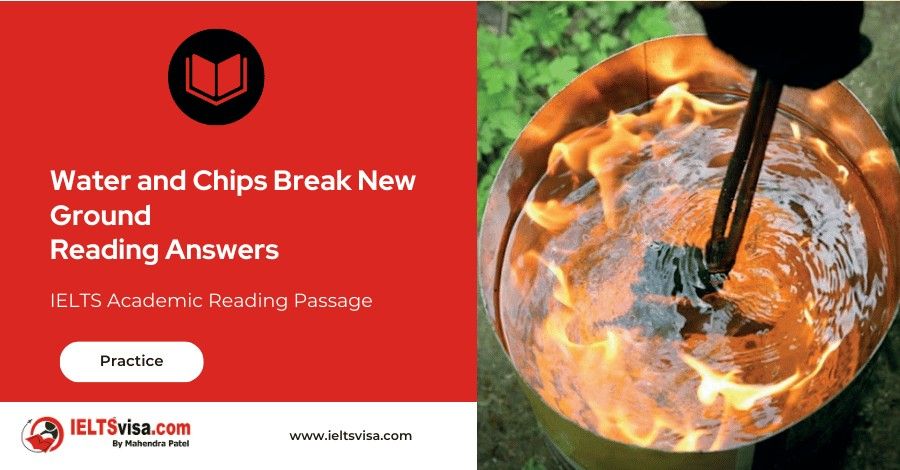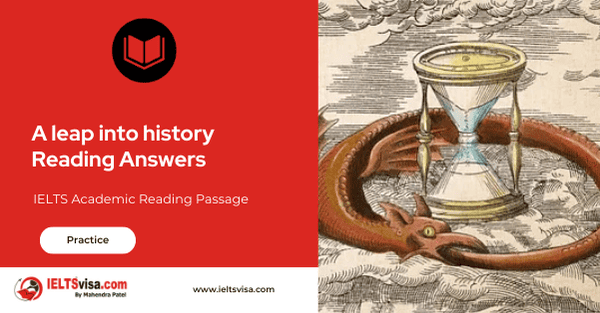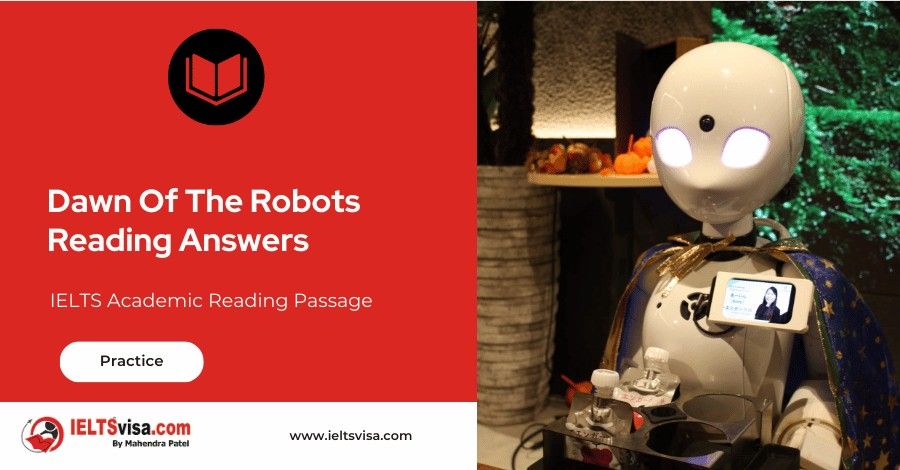Water and Chips Break New Ground Reading Answers
IELTS Academic Reading Passage
Computers have been shrinking ever since their conception almost two centuries ago, and the trend is set to continue with the latest developments in microchip manufacturing. The earliest prototype of a mechanical computer was called the Difference Engine, and was invented by an eccentric Victorian called Charles Babbage. It weighed over 15 tons and had 26,000 parts. Colossus, the first electronic computer, did not appear until the end of WWTI, and with its 1,500 vacuum tubes was even more complex and much heavier than its mechanical predecessor.
It was only when the silicon-based microchip was invented in the early 1950s that computers started to become more compact. The first microchip computers were very complex and had more than 100,000 transistors, or electronic switches; however, they were still rather bulky and measured several metres across. Nowadays microchips are measured in nanometres (nm)-that is, in billionths of a metre-and the search for even smaller microchips continues as scientists work on new methods of microchip production.
Today, most microchips are shaped by a process called lithographic etching, which uses ultraviolet (UV) light. A beam of UV light with a wavelength of only 193 nm is projected through a lens on to an etching mask, a micro device with slits, or long narrow cuts. When the UV light hits the surface of silicon chips, it removes microscopic layers of silicon to create patterns for the microchips circuits. Microchips with features as small as 65 nm can be created with this wavelength.
However, lithographic etching is unable to make chips much smaller than 65 nm due to the fundamental properties of light. If the slit in the mask were made narrower, the air and nitrogen used in the space between the lens and the etching mask would diffuse the light, causing a blurred image. This means that 193-nm UV light cannot be used to produce microchips with features smaller than 65 nm. Manufacturers know that they need to go even smaller for the technological demands of this century, and they are looking for new methods of making microchips.
One approach to solving the problem is to use microscopic mirrors to focus X-rays rather than ultraviolet light. X-rays with a wavelength of less than 25 nm can be created, allowing engineers to make components smaller than 15 nm. The process is known as X-ray lithography etching. However, this technology is extremely expensive, so manufacturers are continuing to search for a cheaper alternative.
A technology called immersion lithography might be the solution. Although liquids are not commonly associated with computers, a tiny drop of water may be all it takes to make microprocessors smaller and more powerful. Intel and IBM, who made the first microprocessors, have recently developed a unique method of microchip production, which uses water droplets to enable manufacturers to shrink the chips-and at a reasonable price! The new microchip is produced by using a drop of water to narrow the gap between the light source and the etching mask, and shorten the wavelength of the UV light to less than 34 nm. This process can be used to manufacture microchips as small as 45 nm, or possibly even smaller.
Initially, engineers feared that air bubbles and other contaminants in water drops would distort the light and ruin the microchip etching process, and the first experiments proved these fears to be well-founded. The problem was overcome by using high-purity water, free of air and other substances. Scientists are also experimenting with liquids other than water-denser liquids such as hydrofluoric acid-which may allow the wavelength to be shrunk still further, thus producing even smaller chips.
IBM have already successfully implemented immersion lithography on some of their production lines and created a fully-functioning microprocessor. IBM also claim that they are able to produce microchips with very few defects.
Although immersion lithography is very new, it is highly promising as it will make the production of 45 nm and 32 nm chips commercially viable. It is a significant milestone in chip manufacturing and will help to bring the costs of the chip down without fundamentally changing the microchip production processes.
In the near future, the ground-breaking technology of immersion lithography will enable computer manufacturers to make powerful microchips that will be used in electronic devices smaller than a coin. This will open up new opportunities in the ever-shrinking world of digital technology.
Questions 30-34:
Do the following statements agree with the information given in the reading passage?
TRUE – if the statement is true according to the passage
FALSE – if the statement is false according to the passage
NOT GIVEN – if the information is not given in the passage
30. The first electronic computer weighed more than the first mechanical prototype.
31. Computers started to shrink with the invention of the microchip.
32. In early 1950s engineers used ultraviolet rays to build the first microchip.
33. X-ray lithography is an inexpensive alternative technology to lithographic etching.
34. Immersion lithography has enabled microchip manufacturers to produce higher quality computer chips.
Questions 35-40:
Complete the table below.
Write NO MORE THAN THREE WORDS from the passage.
|
Method |
Light Used |
Wavelength |
Material used to condense light |
|
Lithography |
Ultraviolet |
193 nm |
Air or 38……….. |
|
Immersion lithography |
35………….. |
36…………… |
39……………. |
|
X-ray lithography |
X-rays |
37……………. |
40……………. |
Question 35:
Question 36:
Question 37:
Question 38:
Question 39:
Question 40:

Solution For: Water and Chips Break New Ground
Reading Answers
| 30 True | 31 True |
| 32 Not Given | 33 False |
| 34 True | 35 UV |
| 36 less than 34 | 37 less than 25 |
| 38 Nitrogen | 39 Water drops |
| 40 Microscopic mirrors |
Review and Practice
- Regularly practice with IELTS reading samples and time yourself to get used to the pressure of the exam.
- Review your mistakes to understand where you went wrong and how to avoid similar errors in the future.
Our Books
Master IELTS Speaking Part 1
IELTS Writing Task 1 Book
IELTS Writing Task 2 Book
Water and Chips Break New Ground Reading Answers Explanation
Comin Soon
Practice IELTS Other Modules
IELTS Listening
The IELTS Listening test assesses how well you can understand spoken English in various contexts. It lasts about 30 minutes and is divided into four sections with a total of 40 questions. The listening tasks become increasingly difficult as the test progresses.
IELTS Academic Reading
The IELTS Academic Reading section assesses your ability to understand and interpret a variety of texts in academic settings. It is designed to evaluate a range of reading skills, including skimming for gist, reading for main ideas, reading for detail, understanding inferences, and recognizing a writer's opinions and arguments.
IELTS Speaking
The IELTS Speaking test assesses your ability to communicate in English on everyday topics. It lasts 11-14 minutes and consists of three parts: introduction, cue card, and a discussion based on the cue card topic.
IELTS General Reading
IELTS General Reading tests your ability to understand and interpret various types of texts. Here are some key areas and types of content you can expect to encounter in the reading section, along with tips for effective preparation.
IELTS Academic Writing Task 1
In IELTS Academic Writing Task 1, you are presented with a visual representation of information, such as graphs, charts, tables, or diagrams, and you are required to summarize, compare, or explain the data in your own words.
IELTS General Writing Task 1
In IELTS General Writing Task 1, you are required to write a letter based on a given situation. The letter can be formal, semi-formal, or informal, depending on the prompt. Here’s a breakdown of the key components to include in your letter
IELTS Academic Writing Task 2
In IELTS Academic Writing Task 2, you are required to write an essay in response to a question or topic. Here’s a guide to help you understand the essential elements of this task
IELTS Exam Tips
To succeed in the IELTS exam, practice regularly, familiarize yourself with the test format, improve your vocabulary, develop time management skills, and take mock tests to build confidence.
Grammer for IELTS
Grammar is the foundation of effective communication in English. Understanding tense usage, subject-verb agreement, and sentence structure enhances clarity and coherence in writing and speaking.
Vocabulary for IELTS
Vocabulary plays a crucial role in the IELTS (International English Language Testing System) exam, especially in the Speaking and Writing sections. Here’s an overview of why vocabulary is important and how it impacts your performance
RECENT IELTS SAMPLES QUESTIONS AND ANSWERS
Ditching that Saintly Image
A. Charities, it is still widely believed, are separate from the government, staffed entirely...
Sleep apnea
1. Sleep apnea is a common sleeping disorder. It affects a number of adults comparable to the...
A leap into history
A Between the Inishowen peninsula, north west of Derry, and the Glens of Antrim, in the east...
Caves
Caves are natural underground spaces commonly those into which man can enter. There are three...
Cure-all Pills: Myths or Reality?
Browse the shelves of any health food shop or pharmacy and you’ll find dozens of dietary...
Dawn Of The Robots
A. At first glance, it appeared to be a typical suburban road accident. A Land Rover...













